SURVIVORS AND EYEWITNESS REPORTS FROM HIROSHIMA
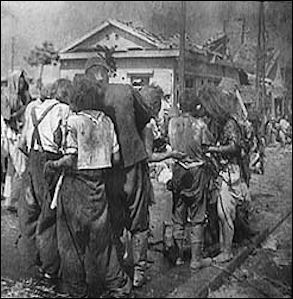
Survivors
Dwight Garner wrote in the New York Times: “The term “ground zero” originated with Hiroshima and Nagasaki. Those who survived up-close encounters with these new American bombs did so thanks to sheer, blind good fortune. They were in exactly the right place at the right time, sheltered from the gamma and infrared death rays, and then from the flattening blast, in spots that acted as natural shock cocoons. [Source: Dwight Garner, New York Times, January 19, 2010]
Marcel Junod, a French journalist who visited Hiroshima on September 9, 1945, reported the first details of the blast to West. A Japanese journalist told him: "On August 6th there wasn't a cloud in the sky above Hiroshima...At nine minutes past seven an air-raid warning sounded and four B-29 planes appeared...Two, after having circled the neighborhood of Shukai, flew off at high speed southward...At 7:31 the all-clear was given. Feeling themselves in safety people came out of their shelters and went about their affairs...Suddenly a glaring whitish pinkish light appeared in the sky accompanied by an unnatural tremor which was followed almost immediately by a wave of suffocating heat and wind which swept everything in its path." [Source: "Eyewitness to History", edited by John Carey, Avon Books, 1987]
One survivor who was six at the time of the blast and was catching cicadas with his 3-year-old sister 1.3 kilometers from bomb’s hypocenter grabbed his sister and ran into a nearby hut when he saw the white light and heard the explosion. The two siblings were struck by a blast of hot air which caused a stem of bamboo to rip into the boy’s abdomen, Afterwards he carried his burned and bleeding sister on his back and wandered around the city. For several years after the bombing he often vomited blood. His sister underwent multiple operations for the affects the bombing.
One survivor told filmmaker Steve Okazaki, “From under the rubble, my father cried for help.” Another said, “I couldn’t stand, much less walk. Someone carried me on his back.” One man recalled, “The patients in the hospital, both adults and children, would hear the nurses coming down the hall and as they approached, everyone would beg to be killed.”
RELATED ARTICLES IN THIS WEBSITE: OKINAWA, KAMIKAZES, HIROSHIMA AND THE END OF WORLD WAR II factsanddetails.com; IWO JIMA AND THE DRIVE TOWARD JAPAN factsanddetails.com; BATTLE OF OKINAWA factsanddetails.com; SUFFERING BY CIVILIANS DURING THE BATTLE OF OKINAWA factsanddetails.com; KAMIKAZES AND HUMAN TORPEDOES factsanddetails.com; KAMIKAZE PILOTS factsanddetails.com; FIRE BOMBING ATTACKS ON JAPAN IN WORLD WAR II factsanddetails.com; DEVELOPMENT OF ATOMIC BOMBS USED ON JAPAN factsanddetails.com; DECISION TO USE TO ATOMIC BOMB ON JAPAN factsanddetails.com; ATOMIC BOMBING OF HIROSHIMA AND NAGASAKI factsanddetails.com; HIROSHIMA, NAGASAKI AND SURVIVORS AFTER THE ATOMIC BOMBING factsanddetails.com; JAPAN SURRENDERS, THE USSR GRABS LAND AND JAPANESE SOLDIERS WHO DIDN'T GIVE UP factsanddetails.com; APOLOGIES, LACK OF APOLOGIES, JAPANESE TEXTBOOKS, COMPENSATION AND WORLD WAR II factsanddetails.com; LEGACY OF THE ATOMIC BOMBING OF JAPAN AND OBAMA'S VISIT TO HIROSHIMA factsanddetails.com; LEGACY OF WORLD WAR II IN JAPAN factsanddetails.com
RECOMMENDED BOOKS: “Hiroshima” by John Hersey Amazon.com, based on accounts of six survivors published in The New Yorker in August 1946; “Hiroshima Nagasaki: The Real Story of the Atomic Bombings and Their Aftermath” Illustrated, by Paul Ham Amazon.com; “Hiroshima Diary: The Journal of a Japanese Physician, August 6-September 30, 1945" by Michihiko Hachiya Amazon.com; “Flash of Light, Wall of Fire: Japanese Photographs Documenting the Atomic Bombings of Hiroshima and Nagasaki” by The Dolph Briscoe Center for American History Amazon.com; “Surviving Hiroshima: A Young Woman's Story” by Anthony Drago, Douglas Wellman Amazon.com; “Hiroshima Notes” by Kenzaburo Oe , David L. Swain, et al Amazon.com; “Enola Gay: Mission to Hiroshima” by Gordon Thomas, Max Morgan-Witts, et al. Amazon.com ; Amazon.com; “The Making of the Atomic Bomb” by Richard Rhodes Amazon.com, won the Pulitzer Prize and National Book Critics Circle Award; “American Prometheus” by Kai Bird and Martin J. Sherwin, The Inspiration for the film “Oppenheimer” Amazon.com; “Hiroshima: Why America Dropped the Atomic Bomb” by Ronald Takaki, a Berkeley historian Amazon.com ; “Countdown 1945: The Extraordinary Story of the Atomic Bomb and the 116 Days That Changed the World by Chris Wallace Amazon.com
Zone of Death
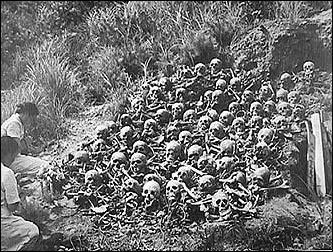
People near ground zero vaporized instantly without a trace. Those further away were carbonized into black, smoking heaps. Those further away still had their eyeballs melted and their features burned off their faces. Some had the patterns on their clothes tattooed on their bodies.
The Japanese journalist told Junod: "Within a few seconds the thousands of people in the streets and the gardens in the center of town were scorched by a wave of searing heat. Many were killed instantly, others lay writhing on the ground screaming in agony from the intolerable pain of their burns. Everything standing upright in the way of the blast, walls, houses, factories and other buildings, was annihilated and the debris spun round in a whirlwind and was carried up into the air." [Source: "Eyewitness to History", edited by John Carey, Avon Books, 1987]
"Trams were picked up and tossed aside as though they had neither weight or solidity. Trains were flung off the rails as though they were toys. Horses, dogs and cattle suffered the same affects as human beings. Every living thing was petrified in an attitude of indescribable sufferings. Even the vegetation did not escape. Trees went up in flames, the rice plants lost their greenness, the grass burned on the ground like dry straw."
"Beyond the zone of utter death in which nothing remained alive houses collapsed in a whirl of beams, bricks and girders. Up to about three miles from the center of the explosion lightly built houses were flattened as though they had been built of cardboard. Those who were inside were either killed or wounded. Those who managed to extricate themselves by some miracle found themselves surrounded by a ring of fire. And those who succeeded in making their way to safety generally died twenty minutes or thirty days later from the delayed effects of the deadly gamma rays...Some of the reinforced concrete or stone buildings remained standing but their interiors were completely gutted by the blast...By evening the fire began to die down and then it went out. There was nothing left to burn."
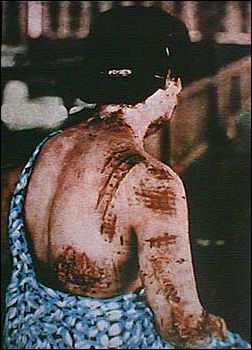
Badly burned
"Those who were able walked silently towards the suburbs and distant hills, their spirits broken, their initiative gone. When asked whence they had come, they pointed to the city and said, 'That way.'; and when asked where they were going , pointed away from the city and said , 'This way.' They were so broken and confused they behaved like automatons...Some had followed the railways, some as of if by instinct had chosen footpaths and paddy fields, whereas others found themselves shuffling along dry river beds. each to his own course for no other reason than the presence of another in the lead...As the day ended it might as well have been suspended in time, for we had no clocks and no calendars.”
Hiroshima Survivors
A surprising number of people survived, including some that were within a mile of ground zero. Many of the survivors walked around dazed and naked, their clothes burned off by the fires or blown away by the shock waves. Some had so much of their body burned away it was difficult to determine who were men and who were women. People who wore white clothing, which reflected some of the energy from the blast, fared better than those who wore black clothing.
Dwight Garner wrote in the New York Times: The Hiroshima survivors learned invaluable lessons about surviving a nuclear detonation, but they were discouraged from disseminating this knowledge in the immediate aftermath. Japan’s military leaders did not want to spread “bad stories” and “rumors of defeat.” Some of these survivors talked anyway. They surely saved some lives. [Source: Dwight Garner, New York Times, January 19, 2010]
One Hiroshima survivor who was about a kilometer away from ground zero told the Daily Yomiuri, “I was on my way to class, when there was a huge explosion. The blast threw me about 10 meters, knocking me unconscious. When I came to I realized my face and arms were severely burned and swollen.”
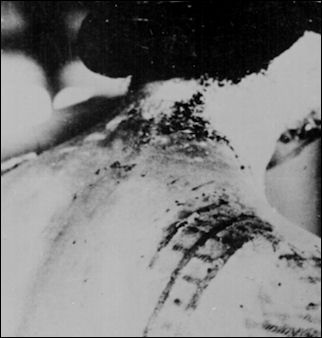
close up of the burns
One man within 1.3 kilometers of the center of the blast was burned so badly two of his finger were fused together, yet he survived. Another man, who was at the Hiroshima train station at time of the blast, recalled sand filling his mouth and heat scorching his body. He immediately leapt into a tub of water used for emergency fires.
Survivors that dragged themselves to hospitals and clinics found them in ruins like everything else around them. Many fled towards the hills surrounding the city. These survivors recall being showered with black rain and watching the flattened city go up in flames and smoke. Some jumped into the river to escape the heat burning their bodies. Marcel Junod, a French journalist who visited Hiroshima on September 9, wrote: "Hiroshima was laced by seven tributaries of the Ota River. Survivors ran to the rivers with skin hanging off them in shreds, moaning "Mizu, mizu!" (Water, water). Their temperatures had left them dehydrated and their injuries made them seek some kind of relief.” [Source: “Eyewitness to History “, edited by John Carey, Avon Books, 1987]
One Hiroshima survivor told the Asahi Shimbun: “I saw badly charred bodies all jumbled together close to the riverbank where the reeds were growing. The internal organs of one body had spilled out. Another had no head. My knees were literally knocking together as I took in the scene. It looked like hell on Earth.”
Tomiko Shoji: Hiroshima Survivor
Sarah Stillman wrote in The New Yorker, “Tomiko Shoji was struck and sent aloft by a bright white light. She’d just arrived at her secretarial job, at a tobacco factory, and was standing by the door when the flash occurred... She flew backward under the crushing force of the office door, passed out, and awoke with shards of glass in her head and an expanse of bodies around her—some dead, some alive but dazed, and many more, she soon found, floating “like charcoal” in nearby rivers.[Source: Sarah Stillman, The New Yorker, August 12, 2014 |~|]
“Shoji recalls briefly losing consciousness at the Bureau of Tobacco. “When I got up, I ran down to the first floor, down to the bomb shelter,” she said. “All over was smoke; the entire city was covered with smoke. I saw people coming across the bridge just completely black—covered by blood, coming towards us. … The whole city was a sea of fire. And then, at night, it rained black rain.” |~|
“Collecting herself, she began walking with colleagues across the city’s many bridges, toward the sea. She caught a train in Hiroshima’s west hoping to find her sister, to no avail; en route were whole trolley cars that had been blown off their tracks, filled with singed corpses. After spending the night, she returned home to find a note from the same sister, which read, “You can find me at the school.” The two stayed in the school turned shelter for some time thereafter, living in a true dystopia. “There were tens of thousands of flies from the dead bodies,” she recalled. “Our greetings to each other became: are you having diarrhea?” |~|
Shizuko Yamasaki Emerges from Her Hiroshima Flattened House
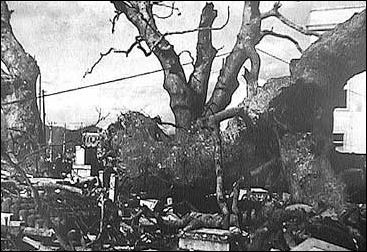
Shizuko Yamasaki was at home with her son at time of the Hiroshima blast. She wrote in Newsweek. "It was a very hot day. I came out of an air-raid shelter with my 2-year-old son, Atsunori, a little before 8. It was breakfast time, and we hurried back to our wooden house. I was just about to hand him a bowl of rice when rays of a strange bluish and whitish light came in through the kitchen window, brushed my right cheek and hit Atsunori right in the eyes. I held him tight to my bosom as the house was lifted and moved by the blast." [Source: Newsweek, March 15, 1999]
The next moment I found myself crushed underneath the collapsed house. It was pitch dark and I couldn't move an inch with the roof, walls and rubble on my back. All I could think of was 'I'm going to die here. Then something moved under my body. It was Atsunoru begging for help and crying with pain."
"The mushroom cloud must have gone, and I saw a ray of sunlight coming through . All I could do was dig the ground with my hand like a snail toward the sunlight...Covered with mud and blood, I pushed my son out, then came out of the fallen house to see a kind of Hiroshima I had never seen---a destroyed city much worse than a living hell."
"I saw people...with their skin peeling and hanging like seaweed, and there were charred bodies inside the burned trams. Carrying Atsunori, whose body was slippery with blood, I rushed to the riverbank, surrounded by the injured and corpses."
Dr. Michihiko Hachiya’s Account of Hiroshima
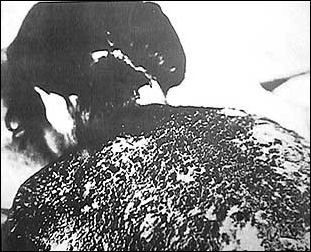
One of the most graphic descriptions of the horrors at Hiroshima came from Dr. Michihiko Hachiya, who lived 1,700 meters from the hypocenter. In a 1955 publication entitled Hiroshima Diary he wrote: "The hour was early; the morning still, warm, and beautiful...Clad in drawers and undershirt, I was sprawled on the living room floor exhausted because I had just spent a sleepless night on duty as an air warden in my hospital.” [Source: Michihiko Hachiya, Hiroshima Diary, 1955]
“Suddenly, a strong flash of light startled me — and then another. So well does one recall little things that I remember vividly how a stone lantern in the garden became brilliantly lit...Garden shadows disappeared. The view where a moment before had been so bright and sunny was now dark and hazy. Through swirling dust I could barely discern a wooden column that had supported one comer of my house. It was leaning crazily and the roof sagged dangerously.
Moving instinctively, I tried to escape, but rubble and fallen timbers barred the way. By picking my way cautiously I managed to reach the roka [an outside hallway] and stepped down into my garden. A profound weakness overcame me, so I stopped to regain my strength. To my surprise I discovered that I was completely naked How odd! Where were my drawers and undershirt?....All over the right side of my body I was cut and bleeding. A large splinter was protruding from a mangled wound in my thigh, and something warm trickled into my mouth. My check was torn, I discovered as I felt it gingerly, with the lower lip laid wide open. Embedded in my neck was a sizable fragment of glass which I matter-of-factly dislodged, and with the detachment of one stunned and shocked I studied it and my blood-stained hand.
"We stood in the street, uncertain and afraid, until a house across from us began to sway and then with a rending motion fell almost at our feet. Out house began to sway, and in a minute I, too, collapsed in a cloud of dust. Other buildings caved in or toppled. Fire sprang up and whipped by a vicious wind began to spread."
"It finally dawned on us that we could not stay here in the street, so we turned our steps toward the hospital...We started out, but after 20 or 30 steps we had to stop. My breath became short, my heart pounded, and my legs gave way under me and begged Yaeko-san [his wife] to find me some water. But there was no water to be found...I was still naked, and although I did not feel the least bit of shame, I was disturbed to realize that modesty had deserted me...Hiroshima was no longer a city, but a burnt over prairie. To the east and to the west everything was flattened. The distant mountains seemed nearer than I could ever remember. How small Hiroshima was with its houses gone."
"A naked woman carrying a naked baby came into view. I averted my gaze. Perhaps they had been in a bath. But then I saw a naked man, and it occurred to me that, like myself, some strange thing had deprived them of their clothes. An old woman lay near me with an expression of suffering on her face, but she made no sound. Indeed one thing that was common to everyone I saw — complete silence."
Dead, Wounded and Walking Ghosts at Hiroshima
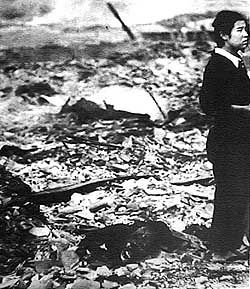
Dr. Hachiya wrote: "The streets were deserted except for the dead. Some looked as if they had been frozen by death while in the full action of flight; others lay sprawled as though some giant had flung them to their death from a great height...Between the Red Cross Hospital and the center of the city I saw nothing that wasn't burnt to a crisp. Streetcars were standing and inside were dozens of bodies , blackened beyond recognition. I saw fire reservoirs filled to the brim with dead bodies who looked as they had been boiled alive. In one reservoir I saw one man , horribly burned, crouching beside another man who was dead." [Source: Michihiko Hachiya, Hiroshima Diary, 1955]
"I paused to rest,” Dr. Hachiya wrote. “Gradually things around me came into focus. There were the shadowy forms of people, some of whom looked like walking ghosts. Others moved as though in pain, like scarecrows, their arms held out from their bodied with forearms and hands dangling. These people puzzled me until I suddenly realized that they had been burned and they were holding their arms out to prevent the painful friction of raw surfaces rubbing together.
One survivor said she happened to seek shelter from the bright summer sunlight in the shadow of a sturdy brick wall, and she watched from there as two children who had been playing out in the open were vaporized in the blink of an eye. Another survivor later told Time magazine, "Big black flies appeared and tried to lay eggs on human flesh. The injured were so weak that they couldn't brush away the flies that nestled on their hands and necks. Some were black from a blanket of flies that covered them."
Junod wrote: "Hiroshima was laced by seven tributaries of the Ota River. Survivors ran to the rivers with skin hanging off the in shreds, moaning "Mizu, mizu!" (Water, water). Their temperatures had left them dehydrated and their injuries made seek some kind of relief. In one blood-stained reservoir there were so many dead people there wasn't enough room for them to fall over.” [Source: "Eyewitness to History", edited by John Carey, Avon Books, 1987]
Damage at Ground Zero
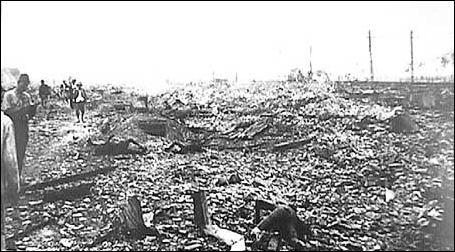
Osborn Elliot, who later became editor-in-chief of Newsweek, visited Hiroshima a couple of weeks after the atomic bomb was dropped. In a letter home he wrote: "The city is/was situated in a valley — on one side the mountains, on the other the seas. As you stand in the middle of town, for miles on every side nothing rises above the level of your knees except for the shell of a building or the grotesque skeleton of a tree or perhaps a mound where the rubble has been pushed into a pile."
"We saw a fire station that seemed in relatively good condition,” Elliot wrote. But inside, the two fire trucks were caricatures of twisted metal. Scattered through the ruins are cash registers, typewriters, bicycles, safes, all oxidized beyond recognition by the heat. Many bottles had been partially melted and twisted into fantastic forms."
Junod said: "At three quarters of a mile from the center of the explosion nothing at all was left. Everything had disappeared. It was a stony waste littered with debris and twisted girders. the incandescent breath of the fire had swept away every obstacle and all that remained were one or two fragments of stone walls and a few stoves which had remained incongruously at their base." [Source: “Eyewitness to History “, edited by John Carey, Avon Books, 1987]
Man Survives Who Was Just 500 Meters Away from Hiroshima Hypocenter
Teruzo Kido survived the blast and radiation from the Hiroshima bomb even though he was only 500 meters from the hypocenter of the blast. The Mainichi Shimbun reported: “Kido was 13 when he survived the bombing. He was waiting for a tram with a classmate to go to the workplace they'd been assigned to under the wartime mobilization of student labor. The classmate said, "Something just dropped," and looked up at the clear sky when everything suddenly went black and he was hurled to the ground. He found his classmate collapsed motionless nearby. [Source: Mainichi Shimbun, August 1, 2014 ||||]
“"Go to Mount Koi," someone shouted and Kido heeded the advice, heading west. On his way to the mountain, he saw the charred body of a schoolgirl holding on to a strap on a tram. That night, Kido looked down on downtown Hiroshima from the mountain and felt, "I'm alone now." His parents and elder sisters were at home at the time of the bombing. His second sister and her husband who lived on the east side of Hiroshima Station took him in.” ||||
“It is still fresh in Kido’s memory that, after the bombing, he helped carry corpses to morgues using wires hooked in the mouths and nostrils of the dead...Kido’s “eldest daughter has repeatedly been admitted to and released from a university hospital to undergo treatment for problems with her thyroid. She still needs regular doses of medication. She blamed her condition on Kido’s exposure to the A-bomb radiation, and even ran away from home. "(In wartime), you never treat people as human beings," Kido laments. "I hate war, but war is being repeated. I feel tired of life...I've lived while trying not to think about what happened to me long ago."
Sunao Tsubio: 'I Had Entered a Living Hell on Earth'
Sunao Tsuboi, the Hiroshima survivor who met with U.S. President Barack Obama in May 2016, was photographed on Miyuki Bridge in Hiroshima three hours after the bombing of Hiroshima.At the time of the blast he was a 20-year-old university student on his way to morning classes. The facial scars he carried for all of his life (he was still alive in 2016) are proof of his experience in a “living hell on earth”. In the photo, one of only a handful of surviving images taken in Hiroshima that day, Tsuboi is sitting on the road with several other people, staring at the gutted buildings around them. To one side, police officers douse schoolchildren with cooking oil to help soothe the pain of their burns. “That’s me,” he told The Guardian. “We were hoping we would find some sort of medical help, but there was no treatment available, and no food or water. I thought I had reached the end.” [Source: Justin McCurry, The Guardian, August 4, 2015]
Tsuboi told The Guardian he remembers hearing a loud bang, then being blown into the air and landing 10 meters away. He regained consciousness to find he had been burned over most of his body, his shirtsleeves and trouser legs ripped off by the force of the blast. Motoko Rich wrote in the New York Times: “His body was burned from head to toe. The pain was so severe that Mr. Tsuboi was certain he would die. He took a small rock and etched on a bridge, “Here is where Sunao Tsuboi found his end.” A classmate rescued him from the bridge and carried him to a military hospital. Several days later, his mother and uncle found him and took him home. It took him a year to walk again. [Source: Motoko Rich, New York Times, May 27, 2016 ~|~]

Hiroshima damage map
Tsuboi, told The Guardian “My arms were badly burned and there seemed to be something dripping from my fingertips... My back was incredibly painful, but I had no idea what had just happened. I assumed I had been close to a very large conventional bomb. I had no idea it was a nuclear bomb and that I’d been exposed to radiation. There was so much smoke in the air that you could barely see 100 meters ahead, but what I did see convinced me that I had entered a living hell on earth.
“There were people crying out for help, calling after members of their family. I saw a schoolgirl with her eye hanging out of its socket. People looked like ghosts, bleeding and trying to walk before collapsing. Some had lost limbs...There were charred bodies everywhere, including in the river. I looked down and saw a man clutching a hole in his stomach, trying to stop his organs from spilling out. The smell of burning flesh was overpowering.”
According to The Guardian: “Tsuboi was taken to a hospital, where he remained unconscious for over a month. By the time he came to, a defeated Japan was under the control of the US-led allied occupation. “I had no idea that the war had ended,” he said. “It was difficult to take in.” Since then Tsuboi has been hospitalised 11 times, including three occasions when doctors told him he was about to die. He takes drugs for several illnesses, including two cancer diagnoses, which he says are connected to his exposure to radiation.”
Survivors Within Two Kilometers of the Hiroshima Hypocenter
Reiko Yamada wrote in Hikakusha Stories: “The area I lived then was 2.6 kilometers from the bomb explosion center. There, most of the houses were destroyed by the blast, but they were not burned. Many injured and burned people fled to this area from the city center. The streets were so crowded with the injured that there was no room for us to walk. My father was about 1 kilometer away from the explosion center. He was rescued from under a fallen building. He narrowly came back home, but he was bloodied all over his body due to wounds caused by pieces of broken glass. [Source: Hikakusha Stories website]
My eldest sister, who was caught by the bomb at Hiroshima railway station, 1.5 kilometers from Ground Zero, came back home in the evening of the second day. She got burned on the neck and the back. As we had no medicine to treat her with, my mother put thin slices of cucumber on her back to cool down the burns, but the cucumber slices soon spoiled because of the heat. They began smelling and flies swarmed. We kept flies away from her, using a fan in turn. She could not sleep and kept on crying with pain.
My 13-year old sister was sick and stayed at home on that day. She survived. All her schoolmates who were mobilized to work near the city center on that day died. (At that time, the first and second graders of junior high school aged 13 or 14 were mobilized to work in building demolition to prevent the spread of fire in the central part of the city, and many of them died or are still recorded as missing)
Survivor Who Was Outside Within Two Kilometers of the Hiroshima Hypocenter
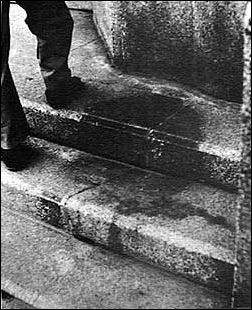
nuclear shadow
According to Hikakusha Stories Shigeko Sasamori was 13 years old when the atomic bomb was dropped on Hiroshima. Hearing the sound of a plane, she looked up to see a B-29 flying overhead — seconds later she was knocked unconscious by the blast. When she came to, she was so badly burned that she was unrecognizable. Shigeko repeated her name and address over and over until she was finally found by her father. Years later she would travel to the United States in 1955 as part of a group of young women known as the Hiroshima Maidens. While in New York, she underwent numerous plastic surgery operations and met her adoptive father, Dr. Norman Cousins. Her story is featured in Steven Okazaki’s award winning film White Light Black Rain. [Source: Hikakusha Stories website]
Shigeko Sasamori told UCLA International Institute: “Well, I was in Hiroshima City. I was junior high, first year. That was the time most of most of the people are working for the government. Men, of course, went to the war. The older people helping the city, breaking down houses, makes big street in case bomb dropped so people could run away. At that time we did not know anything about atomic bombs. But we knew about the fire bombs that happened all the time in big cities like Tokyo and Osaka — big cities having big fire bombs. But Hiroshima never had (fire) bombs dropped. But the city people thought they needed wide streets in case bomb dropped. So people could run away. So they’re breaking houses. So young students like us were mobilized. Students cleared the rubble to make nice streets. On August 6 for the first time we went to work. [Source:UCLA International Institute]
“I heard one airplane and I looked up and saw the plane “going.” Such a beautiful blue sky. Looks like such a beautiful scenes I said to my girl friend next to me, schoolmate, told her, “Look up. The sky so beautiful? “The airplane flying such a nice way.” So we just looked at it. Then I saw something drop, a white thing — Later I heard that it was a parachute. Soon as I saw the white thing coming down then — boom — and knocked me down. I don’t know how long I was unconscious or I have no idea. But when I myself came up I couldn’t see anything or couldn’t hear anything — right - just pitch black. And no noise. Then for awhile just sitting, then stood up. Looked around then pretty soon — like a heavy fog go away and you can see things coming up what I had seen before. Something coming back up. Right? Like that. Blackness going away. Just like a heavy fog going away.
Then, I saw a completely different scene from before — People coming out from center. Hurt people — But no noise. Still I just couldn’t hear anything. I just followed the people nearby going down to riverside. I went by the river and followed them down to the river’s edge — The people, so many people burnt and naked. No skin, some skin coming off. I can’t explain. How horrible it was. Then in my mind — so white. I couldn’t think straight. I couldn’t think. What happened?
Then later I first heard a baby cry. Then I looked aside — hurt burned baby. Mother was also burned too; mother tried to nurse the baby but baby was crying and crying. But that opened my ear and mind. And everything came back to myself.And I said, oh the bomb dropped on top of us. Just like a regular fire bomb. Then I tried to go home or go back to school. But I couldn’t go back that way. Many people coming out pushing out very slowly. Pushing. People so horrible looking.
Then one of the men said go to the other side of the river and run away in case another bomb drops. So I followed the people. Very slowly, maybe a little over mile or so away. Finally got to a place where the damage was not so great and some of the houses were barely standing...One third of my body was burned. All my face, neck, back, half of my chest, shoulders, arms and both hands. It’s a miracle to me. That I walked and run away, over a mile — amazing...My friend who was at my side that I told you who was next to me when we looked into the sky. She died. We couldn’t find her. And many classmates who there died. Some of course survived, like me.
Before I came to America I had some operations — quite a few operations. In Tokyo. Rev. Tanimoto also helped us to go to Tokyo for the operations. My hands were opened. Before all stick together. My fingers stick together. So they were opened in Tokyo...Then I came to America. My skin, chin, neck and chest were stuck together. So they opened — my lips and things operated around here — skin grafts — in stages.” Altogether she thinks she had more than 30 operations.
Damage A Couple Miles from Ground Zero

nuclear shadows
"About two and a half miles from the center of town all buildings had been burnt out and destroyed,” Junod wrote. “Only traces of the foundations and piles of debris and rusty and charred ironwork were left...At three miles from the center of the devastation the houses were already destroyed, their roofs had fallen in and beams jutted out from the wreckage of the walls...Less than four miles away...the roofs of the houses around us had lost their tiles and the grass was yellow along the roadside." [Source: "Eyewitness to History", edited by John Carey, Avon Books, 1987]
Elliot said: "A couple of miles from Ground Zero, two trolleys lay on their sides, along with some cars that had been hurled off the street. Small concrete buildings were swollen out of shape---including a church whose walls bulged outward and whose bell tower formed an S-curve. In a residential district, someone's clothes dangled from a blackened tree branch. By contrast, a nearby shrine appeared untouched by the blast...How anybody was left alive, I don't know." A month after the blast Hiroshima was hit by a devastating typhoon, which exacerbated the misery.
"Here and there, women and children were sitting on the rubble that was once their homes,” Elliot wrote. “We didn't see many wounded---just a few on crutches or with bandages on their heads. Many people had sores on their faces. We stared at them, and they gazed blankly back at us."
Survivors More Than Two Kilometers Away from Hiroshima Hypocenter

Kunihiko Bonkohara wrote in Hikakusha Stories: “I experienced the atomic bombing while living in Funairi, Hiroshima, about 2 kilometers from the hypocenter. I was five years old at the time. We had a family of six. My older brother and sister were primary school students and had been evacuated. Another older sister and my mother were mobilized to work and so had gone into central Hiroshima. Only my father and I were at home at the time. When the atomic bomb was dropped, at the moment of the bright light, my father pushed me under a desk and placed himself on top of me to protect me. My father was blown away by the blast and his body was pierced by shards of glass and wooden rubble. Luckily the building next to our home was a brick factory and so our house did not burn. My father went to a nearby river to wash his body, and when he came back home the black rain began to fall. The city was full of horribly burned people.[Source: Hikakusha Stories website]
One survivor told the Daily Yomiuri she remembers her brother, a third grader at a school 1.2 kilometers from the hypocenter dying in his mother’s arms; her mother’s desire to have the brother cremated in a blanket but giving the blanket to a passerby who needed it; being showered with black rain and not knowing what it was; and another brother who was burned badly and had his wounds treated with a salve made from grated cucumbers every day.
Toshiko Tanaka wrote in Hikakusha Stories: At 8:15 am on August 6th 1945, the atomic bomb was dropped on Hiroshima city, and I was right under that atomic cloud. I was 6 years and 10 months old and was walking to my elementary school. It was 2.3 km from Ground Zero. There was a warning that American bomber planes, B-29's, were coming. And at the moment I looked up the sky, I was attacked by the high heat rays and blinded by the flash. At once, I covered my face with my right arm so I got severe burns on my right arm, head, and left neck. I could not understand what had happened. It was pitch dark around me. This was caused by the dust of the bomb blast contaminated by radioactivity, which is called an atomic cloud. Soon I felt the severe pain of my burned skin. I came back to my house crying. The house was totally destroyed by the blast. My mother was safe at home but could not recognize her own daughter because my appearance had completely changed. My hair was frizzy by the heat, my face and feet were dark by the dust, and my clothes were torn like rags. I remember that I saw a beautiful blue sky through the broken roof. [Source: Hikakusha Stories website]
“After a while, I saw a great number of mortally injured people staggering towards the direction of my house. They were trying to escape. Many of them had their own skin burned and peeled, hanging down from the tip of their fingers. They were dead silent and looked like a procession of ghosts. From that night, I got a high fever and was in a coma for a week. With all the doctors and hospitals gone, my mother thought I was going to die. When I regained consciousness, my town was covered by the horrible smelling smoke coming from the schoolyards and parks because massive dead bodies were cremated there everyday.
Nagasaki Survivors

Yasuaki Yamashita told Hikakusha Stories: “When the A-Bomb fell on Nagasaki, August 9, 1945, I was 6 years old and living there with my family in a typical Japanese-style wooden frame house with sliding interior partitions (shoji) and exterior glass windows. Normally on a hot summer day I would go to the mountain with friends of my age to catch dragon flies and cicadas. However, on this day I was playing at home. Nearby my mother was preparing the mid-day meal. Suddenly, at precisely 11:02, we were blinded by an intense light like 1,000 simultaneous flashes of lightening. My mother pushed me to the ground and covered me with her body. We heard the roar of a great wind and flying debris of the house collapsed on top of us. Then there was silence. [Source: Hikakusha Stories website]
“Our house was 2.5 km. (1.5 miles) from the epicenter. My sister who was in another part of the house was cut by flying splinters of glass. A playmate who went to the mountain that day was exposed to the great blast of heat caused by the detonation of the bomb. His body was badly burned and he died a few days later. My father was recruited to help clean up the destruction in the center of Nagasaki. At the time we didn’t know about the dangers of radiation that would later cause his death.
Second Generation Hibakusha from Nagasaki Miyako Taguchi delivered the following address to the Agape community of Massachusetts on October 10, 2010: “It was the hot summer of August 9th, 1945. Cicadas were screaming as if they were urging people to escape from Nagasaki, but people did not hear them. My father who was 17 years old at the time was working at a big shipyard in Kawanami, 5 miles from the epicenter. However, on that day, he stayed home at Mizunoura, 2 miles from the epicenter because of a leg injury. At 11:02 a.m., when he was sitting at a porch he saw a bright light, and heard the explosion. His house was shaken fiercely and the roof began to fall. He heard people screaming and the loud noise of destruction everywhere. My father and his family escaped to an air-raid shelter, walking through the debris and smoke. After a while, the radioactive black rain from the A-bomb cloud began to fall on them and contaminated acres of Nagasaki city.
“As my father and his family fled to Kurosaki, his father’s hometown, 8 miles from the epicenter, he saw the land covered with black ashes and debris. All the buildings and houses were burned, nothing remained of what he remembered as his city. He saw the black corpse piles. He could not tell the humans apart from animals. Severely burned people with their skin and flesh hanging from their bodies were begging for water. “Give me water! Please give me water!” However, my father did not have clean water and he knew if he gave them water, people would die instantly from the shock. The hovering smell from the burned debris and dead bodies penetrated everything...After some years, the Japanese were told the atomic bomb had targeted the Mitsubishi shipyard very close to my father’s house, but the strong wind carried it 2 miles to the epicenter. If there hadn’t been the wind, my father and his family would have had no chance to survive at all and I would not have been here today.
“While my father was struggling to escape from the burned Nagasaki city, my mother was caring for her sister and brother who suffered from losing their hair, fever, and severe diarrhea. My mother was 11 years old, living in Aikawa, a small town by the sea, 4.5 miles from the epicenter. She and her sister were laughing by the window when they saw the bright light growing like a huge sun. Her sister who was facing the bright light suffered most. My mother was just behind her and did not show the same symptoms. Her father piled newspapers under her sister’s lying body because the diarrhea fluid with blood came out of her body endlessly. Her father collected the strong smelling fluid in a bucket and went to a toilet repeatedly. All my mother’s family feared losing loved ones by a mysterious disease, remembering the loss of their mother from tuberculosis at the time of the war.
More Nagasaki Survivors
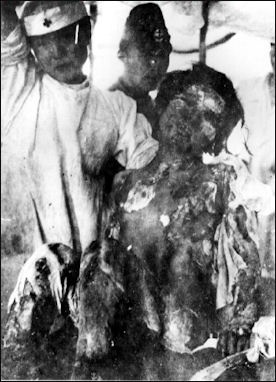
Nagasaki victim
Shigemitsu Tanaka is director of the A-Bomb Survivor’s Council and an atomic bomb survivor. Motoko Rich wrote in the New York Times: Mr. Tanaka, almost 5 years old when the bomb fell, was playing under a persimmon tree on Aug. 9, 1945, when he heard a huge thunderclap and the sky went completely white. All the windows in his family’s home were blown out. His mother went to work at a local elementary school where survivors were taken for medical treatment. There, Mr. Tanaka heard moans and smelled the stench of burning flesh. Mr. Tanaka’s parents suffered from repeated illnesses throughout their lives. His father died from liver cancer 12 years after the bombing.” [Source: Motoko Rich, New York Times, May 27, 2016 ~|~]
Yoshitoshi Fukahori is an atomic bomb survivor and the chairperson of the Research Committee for Photographic Records of Nagasaki Atomic Bombing at the Nagasaki Foundation for the Promotion of Peace. “Mr. Fukahori was 16 and had been conscripted to work in a government office. When the bomb dropped, he dove under a desk. “It was such a loud sound and like lightning, so bright,” he said. “All the air came out of the room.”The night of Aug. 9 he tried to get home, but the main road through the center of town was on fire. On an alternate route through the mountains, he encountered other victims trying to escape, their clothes in tatters and their heads covered in black ash. A woman clung to his leg, begging for water. When Mr. Fukahori reached down to grab her arm, her skin came off in strips.~|~
Miyako Jodai, 76, was 6 when the atomic bomb destroyed her home in Nagasaki. She spent days huddling with other survivors in a cave...Ms. Jodai was living with her grandmother and aunt in the hills of Nagasaki. All she remembers of the moment the bomb exploded is an electric charge of light that knocked her unconscious.With their home destroyed and no food to be found, the family escaped to Fukuoka, about 100 miles to the northeast. They arrived at the home of a distant relative, who offered Ms. Jodai her first warm bath since the bombing. “She was so kind,” Ms. Jodai said. “She said, ‘You have done well to survive.’” ~|~
“Over the thousands of times she has told her story, she has been very frank about her belief that Japan must shoulder some of the blame for the bombings. “I think there were a lot of chances to prevent the situation where the A-bomb was dropped on Japan,” she said. “If we had stopped our aggression, maybe it could have saved Japan from being a victim of a bomb.”
Dutch Japanese POW Views Nagasaki
On the fate of a Dutch prisoner of war who arrived in Nagasaki in early September after working in labor camps in Thailand and Japan, Elizabeth Day wrote in The Guardian: “Later, the Allied troops transported them to Nagasaki where, a few weeks earlier, one of two atomic bombs had been dropped, effectively ending the war. In Nagasaki the scene was one of utter devastation, stretching 3km in every direction. “All you could see were black hills; it was completely black. Here and there was a chimney. All the houses were just stones and rubble, and here and there was a Japanese who tried to get some food from the Americans, but the Americans did not want to share their food. [Source: Elizabeth Day, The Guardian, July 26, 2015 ]
“I remember this fellow, a father who had just bought a bicycle for his son’s birthday, and all that was found was the bicycle, nothing of the son, just the charred remnants of the bicycle. It was just twisted metal... you could not tell what was human and what was not. The whole thing was black, one lot of black rubble.”
“Despite the carnage, Bras admits he felt “no pity. I thought: ‘Good for the Americans.’ Some [former prisoners of war] went back after the war to the same area to show they felt sorry [for the Japanese], but I didn’t feel sorry. I never felt sorry. I feel sorry for the boy [with the bicycle], because the boy was dead, scorched. I feel sorry for that particular case, but I don’t forgive what the Japanese did. They were bastards.”
Hiroshima Survivors Die of Radiation Poisoning

subcutaneous hemorrhage
Many of the atomic bomb victims died days after the blast of radiation sickness The early signs of radiation sickness are "loss of hair, sudden and immobilizing weakness, vomiting, diarrhea, fever on the coldest days, chills at the height of summer, boils, blood spots under the skin, and a massive drop in the white blood cell count. The Japanese called it “atomic bomb disease.”
Before the atomic bomb was dropped on Hiroshima, Gen. Groves said that radiation poisoning did not cause too much suffering and in fact was "a very pleasant way to die." The radiation from Hiroshima toasted the victims’ bone marrow, the source of many of the body's germ fighting agents, and this lowered their natural resistance to disease. The bodies of radiation sickness victims were covered with sores and a disgusting green discharge dripped from their mouths and ears.
Yamasaki wrote: "On the forth day I stood up. Holding my son in my arms, I managed to reach a village over the mountain where my father lived...Soon after the blast, our hair began to fall out and Atsunori developed a serious nose-bleeding problem that continued for years to come." Another survivor said after a month, "My hair fell out, my eyebrows too; I had very beautiful eyebrows." According to one study people that entered Hiroshima shortly after the explosion were exposed to residual radiation equal to the radiation of those who lived 1.3 to 1.5 kilometers from the hypocenter at the time of the bombing, Toshiko Tanaka wrote in Hikakusha Stories: Soon after, many bizarre things happened on the survivors’ bodies. Many people who looked unhurt started to have purple spots on their skin, their hair fell out and their gums began to bleed. And suddenly they died. [Source: Hikakusha Stories website]
Toshiko Tanaka wrote in Hikakusha Stories: “Have you peeled tomatoes in hot water when you make salad? The same thing happens to the human body. Our skin peels by heat. Whenever I see tomatoes, the nightmare comes back to my mind.”
Tsutomu Yamaguchi: Survivor of Hiroshima and Nagasaki
Tsutomu Yamaguchi, who died in January 2010 at the age 93, lived through two atomic blasts, at Hiroshima and then at Nagasaki.Martin Childs wrote in the Independent: “Yamaguchi was the only officially recognised survivor of both the Hiroshima and Nagasaki atomic bomb blasts at the end of the Second World War. Yamaguchi, however, was only formally acknowledged as an Eniijuu hibakusha (double bomb sufferer) by both the Nagasaki and Hiroshima authorities in March 2009. [Source: Martin Childs, the Independent, February 1, 2010]
“On 6 August 1945, Yamaguchi, a young engineer with the shipbuilder Mitsubishi Heavy Industries, was in Hiroshima at the end of a short-term secondment with two colleagues. He recalled hearing engine noise in the skies above, but thought nothing of it as this was commonplace owing to Hiroshima's importance as an industrial city and military base. In fact, what he heard were the engines of the US B-29 bomber, the Enola Gay, which was about to drop the first atomic bomb on the city. Seconds after getting off a tram he saw a flash of light and was knocked to the ground by the force of the bomb, and passed out as it detonated 600m above Hiroshima at just after 8.15am. He later recalled seeing a huge mushroom-shaped pillar of fire rising up high into the sky...Though less than two miles from Ground Zero, he suffered only serious burns to his upper body and a perforated eardrum.
“Yamaguchi spent the night in the city in an air-raid shelter with people dying and screaming out with pain all around him. The following day, Yamaguchi and his two colleagues navigated through the piles of burnt and dying bodies in order to catch a train the 180 miles back to their home, Nagasaki which, like Hiroshima, was an important industrial and military base. Upon his return and with his burns swathed in bandages, Yamaguchi reported for work on 9 August. His boss and co-workers listened with incredulity as he described how a single bomb had destroyed the city.
“At 11.02am, and once again less than two miles from the centre, Yamaguchi saw a familiar flash of light... This time a 25-kiloton plutonium bomb exploded above Nagasaki, throwing Yamaguchi to the ground... Yamaguchi, his wife and baby son survived and spent the following week in a shelter near what was left of their home.
“Yamaguchi's two hellish experiences and their effect upon his family were considerable. As well as almost total deafness in one ear, his skin wounds were bandaged for 12 years, and his wife was poisoned from the radioactive fall-out. She died in 2008, aged 88, of kidney and liver cancer. Their son, exposed to the Nagasaki radiation at six months old, died in 2005, aged 59.
“Much of this turned Yamaguchi into a passionate anti-nuclear weapons campaigner but he never expressed any anti-Americanism. He gave talks about his experiences and often expressed the hope that such weapons would be abolished: "I can't understand why the world cannot understand the agony of the nuclear bombs. How can they keep developing these weapons?" He wrote books and appeared in a documentary, Nijuuhibaku, [Twice Bombed, Twice Survived], which was screened at the Uniated Nations in New York in 2006, when he also addressed the UN, urging them to abolish nuclear weapons.
“As a registered survivor of the Nagasaki bombing, Yamaguchi owned a pale violet copy of the Atomic Bomb Victim Health Handbook since 1957, which entitled him to monthly allowances, free medical check-ups and funeral costs. More than 260,000 others were similarly covered. In March 2009, Yamaguchi was finally certified by the Japanese government, and so acknowledged as having Eniijuu hibakusha status. "My double radiation exposure is now an official government record," he said. "It can tell the younger generation the horrifying history of the atomic bombings even after I die." Yamaguchi, who died of stomach cancer, viewed his ordeals as a cruel twist of fate, a "path planted by God". "It was my destiny that I experienced this twice and I am still alive to convey what happened," he said.
Dwight Garner wrote in the New York Times, “He was a man with very good luck, or very bad luck. It’s hard to decide. But Mr. Yamaguchi wasn’t alone. He was one of as many as 165 people who are believed to have survived Hiroshima only to wind up in Nagasaki when that bomb fell three days later. [Source: Dwight Garner, New York Times, January 19, 2010]
BBC Apologizes for Jokes about Hiroshima-Nagasaki Survivor
In January 2011, Richard Lloyd Parry wrote in the Times of London: The BBC has apologised to Japan for an episode of the comedy quiz QI in which Stephen Fry joked about Yamaguchi being the “Unluckiest man in the World.” The BBC and Talkback Thames, the company that produces QI, issued a joint statement of apology, which was reported on Japan's evening television news bulletins last night after the joke angered many Japanese, including survivors of the atomic bombings. [Source: Richard Lloyd Parry, Times Online, January 22, 2011]
“Fry, the host of QI, joked as he told Yamaguchi's story, in a December 2010 broadcast of the show. “Dressed in a Hawaiian shirt, and garlanded with flowers, he made the audience laugh as he said: "He's either the luckiest because he survived an atom bomb twice, or the unluckiest."One of his guests, the comedian Rob Brydon, said: "Is the glass half-full or is it half-empty? Either way, it's radioactive, so don't drink it." Other members of the panel joked about the efficiency of the Japanese railway system, which resumed service the day after an atomic bombing.
“Speaking on the 9 o'clock news on NHK, Japan's equivalent of the BBC, Yamaguchi's daughter, Toshiko, said: "I cannot forgive the atomic bomb experience being laughed at in Britain, which has nuclear weapons of its own. I think this shows that the horror of atomic bomb is not well enough understood in the world. I feel sad rather than angry."
“On January 7, Ken Okaniwa, Minister at the Japanese Embassy in London, sent a letter of complaint to the BBC and Talkback Thames. "We realise that they were not mocking Mr Yamaguchi so much as the British rail system," Daisuke Tsuchiya, a spokesman for the embassy, told The Times. "But it was totally inappropriate and insensitive to refer to his experience in this sort of programme." A joint statement by the organisations said: "We are sorry for any offence caused. QI never sets out to cause offence with any of the people or subjects it covers, however, on this occasion, given the sensitivity of the subject matter for Japanese viewers, we understand why they did not feel it appropriate for inclusion in the programme."
Image Sources: National Archives of the United States; Wikimedia Commons; Gensuikan;
Text Sources: National Geographic, Smithsonian magazine, New York Times, Washington Post, Los Angeles Times, Times of London, The Guardian, Yomiuri Shimbun, The New Yorker, Lonely Planet Guides, Time, Newsweek, Reuters, AP, AFP, Wikipedia, BBC, “Eyewitness to History “, edited by John Carey ( Avon Books, 1987), Compton’s Encyclopedia, “History of Warfare “ by John Keegan, Vintage Books, Eyewitness to History.com, “The Good War An Oral History of World War II” by Studs Terkel, Hamish Hamilton, 1985, BBC’s People’s War website and various books and other publications.
Last updated November 2012
